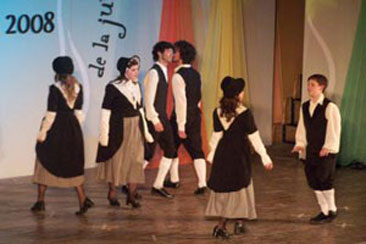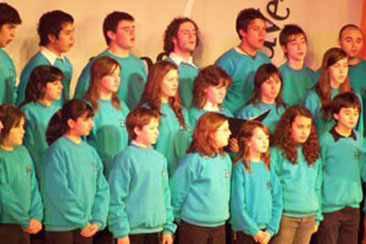Eisteddfod, a traditional festival See map
In October, and since 1875, is celebrated in Chubut an activity that is part of Welsh culture and is deeply rooted in this area because it had came and settled with the first settlers as part of cultural heritage the area.
 One of the typical dances.
One of the typical dances.This is the Eisteddfod Festival, a musical and literary event with the participation of various branches of art as the lterature, recitation in Welsh and Castilian, singing, dancing, painting, drawing and photography, among others.
It is one of the oldest cultural events, being able to trace its origin already in the eleventh century. In the beginning they were called bards, heirs to the tradition, which began with such activities.
The Eisteddfod began as a literary competition and now encompasses several branches of art, the main are literature and choral singing. The name of the festival is a Welsh word, its pronunciation based on phonetics would be "eistedvod" and the origin of it derives from the verb "eistedd" (sit) and is translated as "being sit".
Each of the competitions is responsible for, not a prize fight, but a learning and joy opportunity to share a rewarding experience. Participation in events is open to any person or group that want to do it, because no one is specifically invited to do so although everyone in general.
 The choirs participating in the contest.
The choirs participating in the contest.An organizing committee, elected at the assembly, produced annually the Festival program that is divided into two dates from 2009. For September in Gaiman, the Youth Eisteddfod, and for October in Trelew, the Chubut Eisteddfod. These places have become permanent headquarters, unlike earlier times when raising a large tent meetings took place in different places each year.
The 2009 edition counted with the visit of Dic Jones, who won the chair of the Poet in Chubut Eisteddfod in 1965 with his poem "Mintai'r Mimosa", a reference to the "Mimosa", the schooner that brought the Welsh to Argentine territory. Dic Jones is known in literary circles as Dic yr Hendre.
The award
The award relates to the origin of the word. In 1451, in Wales, the winner was awarded with two silver chairs used as pendants. Then in the Dolgellau Eisteddfod (Wales) in 1794, the winner was awarded with an oak chair made by a craftsman. Since then the highest award is a wooden chair that is known as the "Chair of the Bard".
Source: www.trelewpatagonia.gov.ar
Photos: courtesy of www.eisteddfod.org.ar
Viajes por la Patagonia
Related Articles
© Patagonia.com.ar 2025 | Todos los derechos reservados.
